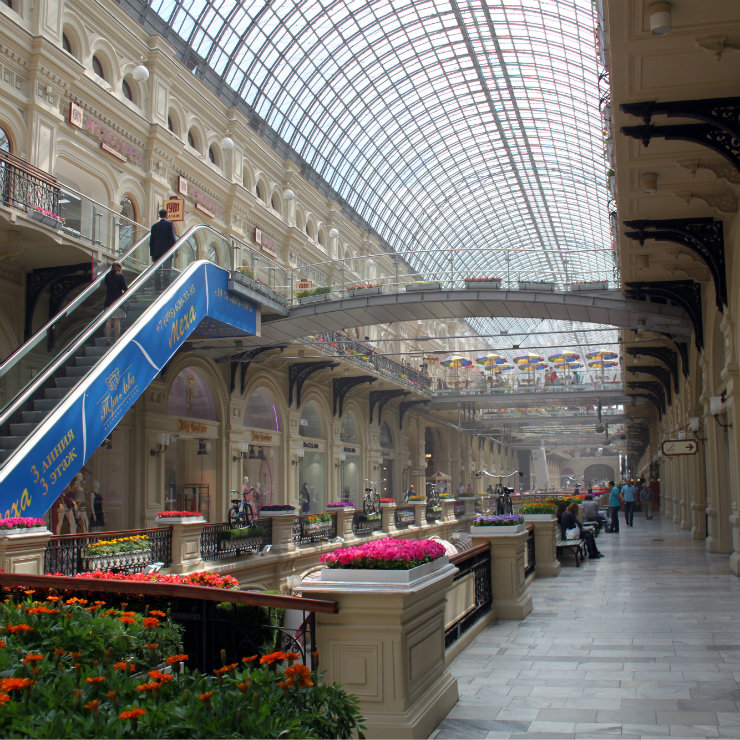
GUM shopping mall, Moscow, Russia (flowcomm, CC BY 2.0)
According to the report the amount of those in Russia who can be thought of as making up the country’s middle-class have been declining since 2017. In order to be considered a middle-class individual in Russia one needs to bring home a monthly wage representing 75 to 200 per cent of the median income in the country, which currently stands at RUB35,000 Rubles (EUR488). This means that Russians aspiring to be considered middle-class need to be earning anywhere between RUB26,000-70,000. Alpha Bank analysts stress that this description would apply to roughly 50 per cent of Russia’s population.
However, there are a few additional factors the authors of the study take into consideration. For example, 27 per cent of all purchases in Russia are made to obtain basic food products. Moreover, according to a survey carried out by Rosstat in 2018, only 32 per cent of Russians could spend money on items other than food, rent, and basic necessities.
After taking these data into account, the wage range Russians need to fit in to be considered middle-class was adjusted to RUB39,000-99,000, or 110 to 250 per cent of the median wage. In 2003, 34 per cent of Russia’s population found itself in this range. In 2014, the number increased to 37 per cent. However, it fell down in 2017 to 30 per cent and has been stagnating since.
The same situation is observed all around the world, the study says. In the period from 1980 to 2016, the working class average wage grew by 120 per cent, and the upper classes’ wage grew by 235 per cent. Meanwhile, the global middle-class’ income grew only by 40 per cent during the same period.
The same has been happening in Russia, according to the analysis. The middle-class has been losing ground. People from this social group have been spending less on vacation, education and health care, all considered traditionally middle-class domains. Instead, they have been spending increasingly more on basic items, including food.
Moreover, the amount of new businesses in Russia has been declining. In 2000, 17 per cent of all wages in Russia have been generated by entrepreneurial activity. This number fell to 9 per cent in 2017.
The data suggests that people in Russia have become more risk averse. In practice, this means that instead of opening new businesses, many people rather look for more secure jobs within the public sector and the government.
In 2003, 10 per cent of Russians were employed by the government. In 2017, this number went up to 15 per cent. According to Levada Center, the amount of people willing to take on an easy job with modest payment went up from 41 per cent in 2015 to 46 per cent in 2017.
Sberbank’s Ivanov Index
Another similar study was commissioned by Sberbank, Russia’s largest financial institution. It tackles the process of studying the country’s middle-class from a slightly different angle. The so called “Ivanov Index” attempts to find out how many people in Russia consider themselves to be members of the country’s middle-class.
According to Yaroslav Lissovolik, head of the analytics department at Sberbank CIB, it’s mainly people who have enough money to travel to foreign countries, eat in restaurants, and save some money at the end of each month. They consider themselves as the middle-class.
The amount of people self-identified as the middle-class has shrunk from 60 per cent in 2014 to 47 per cent in 2019. “The fastest the self-identified middle-class shrank was between 2015 and 2017,” Mr. Lissovolik told Vedomosti.
Conversely, the amount of people who consider themselves as “low income class” has grown significantly in recent years. This concerns those Russian citizens who can only afford the most basic necessities. According to the study by Sberbank, their share grew from 35 per cent in 2014 to 48 per cent today. The study also shows that Russians’ real disposable incomes have been decreasing since 2014.
Global middle-class on decline
The shrinking of Russia’s middle-class is certainly not merely local phenomena. According to a recent study by OECD “Under Pressure: The Squeezed Middle Class”, the middle-class has shrunk in most OECD countries as it has become increasingly difficult for younger generations to become middle-class (read more).
There is a growing generational divide when it comes to belonging to the middle-class. If almost 70 per cent of baby boomers across all OECD countries were part of middle-income households in their twenties, the same is true only for 60 per cent of millennials today.
One of the key issues is that the cost of lifestyle traditionally associated with the middle-class has increased much faster than the inflation rate. For example, in the 1990s, an average middle-class household spent around one fourth of its income on housing, today it is at least one third of that same income.
According to OECD, to tackle the issue, governments around the world should focus on improving access to high-quality public services and ensuring better social protection coverage. They also need to encourage the supply of affordable housing.
Filip Brokeš is an analyst and a journalist specializing in international relations.

